#Bengali Modern Poetry
Text
Rabindranath Tagore - Role & Contribution in Bengali Poetry
Rabindranath Tagore : Role and Contribution in Bengali Modern Poetry.
What is the role and contribution of Rabindranath Tagore in Bengali modern poetry?
Rabindranath Tagore’s role and contribution to modern poetry in Bengali literature are immense and foundational. His impact extends beyond his poetry to encompass various literary, cultural, and educational dimensions.
Here are key aspects of…
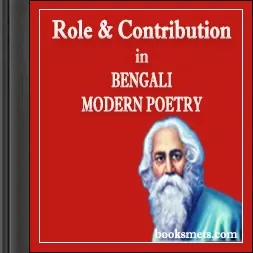
View On WordPress
0 notes
Text
A Note on the Language And History Of Ponniyin Selvan

The indented part is an abridged version of Prof. T. Sriraman's Introduction to C V Karthik Narayanan's English translation of Ponniyin Selvan and the rest is mine.
Kalki is the first significant historical novelist in Tamil. There were a few others before him who had attempted writing in the genre but none of them is read now or even remembered in literary histories. It is important to note the long interval between the birth of the novel as a genre in Tamil and the creation of the subgenre of historical fiction
LANGUAGE
One explanation for this long interval could be that Tamil writers had first to master this new form before they could gain the confidence for attempting the extremely challenging task of writing historical novels.
Also it took centuries for historical information about ancient Tamil Nadu to be suitably incorporated into books of history; it took a long time too for Tamil prose style to evolve.
Kalki’s acknowledged achievement as a writer consists in a transformation of Tamil prose style into a medium eminently suited for discourse — literary, political, even historical — in the modern world. This transformation is similar to the revolution that Subrahmanya Bharati brought about in poetry.
It should be noted that there were debates about the limitations of vernacular languages like Tamil and Malayalam as compared to English.
Bengali historian Jadunath Sarkar, in his 1915 essay Confessions of a History Teacher said that efforts should be made to write history books and teach history in vernacular languages. Then 24 year old K A Nilakanta Sastri (who would go on to become the most prolific historian in South India) wrote a letter opposing this suggestion by saying that "English serves me better as a medium of expression than Tamil – I mean in handling historical subjects. Perhaps the vernacular is not so well off in this part of the country as it should be". This elicited severe criticism from people like Subramanya Bharathi.
Authors like Kalki challenged such notions through their works. But quite funnily, they had to depend on the works of these same historians (Nilakanta Sastri's eponymous work The Cōlas was a main source of Ponniyin Selvan). So we can't say that novels like Ponniyin Selvan are fully free of their influence either.
HISTORY
One way of interpreting Kalki's, or indeed any colonized writer intellectual's attempt to re-create past history is to view it as a psychological, but politically safe, release for his and his race's wounded pride as colonized subjects. As Meenakshi Mukherjee puts it: " . . . any tale of past bravery or heroism vindicated present servitude".
Kalki firmly believed that centuries of political slavery had clearly resulted in a debilitation of body and mind: "“Owing to centuries-long subjugation under foreign rule, the mental firmness and the physical strength of the people of this country have declined. There cannot be two opinions about the need for the men of this country to regain them".
What interested Kalki was political, religious and literary history but not social and economic history, even when they had a bearing on those other histories. The deluding romanticism is obvious but we must say that . . . a tendency to romanticize, can be made with regard only to the historical novels of Kalki and not to the social novels or the short stories.
We therefore return to the question: How historical, how true to history, is Ponniyin Selvan? The broad outlines of the novel do certainly accord with the historical facts. But there are two intriguing questions in the historical account which must surely have caused problems for Kalki in his overall project (agenda, as some of us might choose to call it) of the glorification of the Chozha age.
• The first is the obvious issue of claim: if Parantaka II (Sundara Chozha) was right to ascend the throne after the death of his father (only if Maduranthaka was still a child), was he justified in declaring his own son Aditya II (Karikala) heir-apparent, thus effectively, and well in advance, blocking Maduranthaka's path to the throne?
• The second question concerns the mystery behind the killing of Aditha Karikala.
Besides, and more importantly, everywhere in the novel there are paeans of praise, in prose and verse, for the Chozha Empire (which in fact had not expanded to its full extent at the time presented in the novel).
We have no reason to believe that these historical people behaved in the same way as in the novel. We know that they are as unrealistic and fictional as Nandini or Poonguzhali.
Sundara Cholan was not a lovelorn paralysed man. Aditha Karikalan was was married to multiple women and perhaps even had a son (or multiple children). It is possible that he only participated in battles but didn't kill Veera Pandyan with his own hands. Rajaraja Cholan was a ruthless conqueror. His heir's mother was a relatively under-represented queen. Kundavai did not marry an orphan, landless prince. There was no Senthan - Maduranthakan baby swapping. In fact, it was Arinjayan's line that usurped the throne from the rightful heir Maduranthakan/Uttama Cholan.
So where does this leave us? It leaves us in an imaginary world to enjoy the fiction, history and fictionalised history and have a good time 😄
#ponniyin selvan#ponniyin selvan 2#aditha karikalan#kundavai#arulmozhi#rajaraja chola#vanthiyathevan#vanthiyadevan#vanathi#poonguzhali#vanmozhi
38 notes
·
View notes
Text
International Mother Language Day:History and Significance
For the people of Bengal as well as language advocates and linguists worldwide, International Mother Language Day is a day of enormous importance. Every year on February 21st, the day is commemorated to encourage multilingualism and linguistic diversity, as well as to remember the sacrifices made by language activists in Bangladesh during the Bengali Language Movement.
In the early 1950s, a political and social movement called the Bengali Language Movement emerged in East Pakistan (modern-day Bangladesh). It was a demonstration against Pakistan’s 1948 declaration of Urdu as its sole national language. The majority of East Pakistanis who spoke Bengali believed that the action was discriminatory and infringed their rights to their language and culture. They pushed for the inclusion of Bengali as one of Pakistan’s official languages.
The demonstrations started on February 21, 1952, when Dhaka University students and members of the general public demanded that Bengali be granted the same status as Urdu. In a violent response, the police opened fire on the demonstrators, killing several of them. In East Pakistan, the incident provoked a wave of protests and turmoil.
Together with language, cultural identity, and political independence were also important aspects of the Bengali Language Movement. Intellectuals, students, and political figures led the campaign, seeing language as a means of asserting their rights and seeking a greater say in the affairs of the country. Bengali was eventually recognised as one of Pakistan’s official languages in 1956 as a result of the struggle.
International Mother Language Day, which was established by the UN in 1999, honours the history of the Bengali Language Movement and the sacrifices made by its participants. The purpose of the day is to encourage linguistic and cultural diversity and to increase awareness of the value of mother tongues for social cohesion, education, and communication.
International Mother Language Day is a day of cultural celebration and national pride for the people of Bangladesh. Cultural activities, processions, and the laying of wreaths at the Shaheed Minar (Martyr’s Monument), which was erected in Dhaka in honour of the language martyrs who died on February 21, 1952, commemorate the day. The structure serves as a reminder of the significance of Bengali to Bangladeshis.
The Bengali language is an integral part of the cultural heritage of Bangladesh, as well as of the Indian subcontinent. With more than 250 million speakers, it is the sixth most widely spoken language in the world. Some of the greatest works of literature, poetry, and music in the area were written in Bengali, a language with a long literary history that dates back to the ninth century.
The language of Bengali has also changed over time as a result of the shifting demands and aspirations of its speakers. Sanskrit, Persian, Arabic, English, and other Indian subcontinental languages have all had an impact on it. This has given the language a distinctive grammar and syntax, as well as a rich and varied vocabulary.
In conclusion, International Mother Language Day is an important day for language advocates and linguists around the world, as well as for the people of Bangladesh. This day honours the diversity of languages and cultures and the sacrifices made by the Bangladeshi language martyrs. Bengali language activists and those who support linguistic diversity continue to be inspired by the Bengali Language Movement, which was a pivotal time in the history of the Indian subcontinent.

#bengali#bangla#india#bangladesh#langblr#assam#west bengal#বাংলা#tripura#desi#language learning#international mother language day#languages#kolkata#literature
49 notes
·
View notes
Text
ohk so let's all imagine this.
Thomas loves languages. So i assume he loves travelling too, because then, he gets to explore new languages. Alastair speaks Persian, and tbh Persian was spoken in many South Asian countries as that time (zorashtrians, etc)
Imagine Alastair and Thomas going around south asia and living it up. Thomas knows hindustani (modern day hindi) and urdu. He knows Nepali and Bengali. They travel across modern day India, Pakistan, Bangladesh, Nepal, Bhutan etc while having the time of their lives. They portal in and out of institutes, and bring in souvenirs for their beautiful cirenworth house.
Alastair barters with the rich Persian merchants and gets rich. We all know that Alastair is going to be an amazing politician, so by virtue he's an amazing speaker. Everyone loves him. And they love Thomas too, because even tho he's a white man, he's keen to learn their culture.
They both drink tea in the Mysore, and Hyderabadi palaces with the kings/nawabs. The nawabs gift them beautiful weaponry and paintings.
They take long walks in the palace lawns while men and women admire them through the eyes of ancient Bengali poetry.
They go hunting through the huge jungles. They train with the army and teach the new soldiers how to use weapons.
They wear kurtas with beautiful gold embroidery on it.
At night they sit on the rooftop of the Mysore palace. They look at the city below them with its candle-lit pathways, and the sky above them. They count their blessings along with the stars.
Now this is such a comfort headcannon for me.
#cassandra clare#tsc#the shadowhunter chronicles#thomastair#thomas lightwood#alastair carstairs#the last hours#tlh#tsc headcanons#headcanons#cassieclare#chot#choi#chog#chain of iron#chain of gold#chain of thorns#desiblr#omg this became a borderline fanfic#tsc fanfic#tsc fanfiction
124 notes
·
View notes
Text
culture of India
India, often referred to as the land of diversity, is a cultural kaleidoscope that has fascinated and enchanted people from across the globe for centuries. Its rich heritage, traditions, languages, art forms, and cuisines reflect a civilization that has evolved over millennia, leaving an indelible mark on the world. In this blog, we embark on a journey to unravel the multifaceted culture ,culture of India delving into its historical roots, religious practices, artistic expressions, and modern-day manifestations.

Historical Background:
The cultural history of India can be traced back to ancient times, with evidence of human habitation dating back to the Stone Age. The subcontinent has witnessed the rise and fall of numerous civilizations, including the Indus Valley Civilization, which flourished around 3300 BCE. Subsequent waves of migration and settlement by various ethnic groups, including Aryans, Dravidians, Greeks, Persians, and Mongols, contributed to the diversity of India's cultural landscape.
Religious Diversity:
India is the birthplace of major religions such as Hinduism, Buddhism, Jainism, and Sikhism, and has also been a melting pot of diverse faiths, including Islam, Christianity, Judaism, and Zoroastrianism. The religious tolerance and syncretism prevalent in India have resulted in a vibrant tapestry of rituals, festivals, and spiritual practices that coexist harmoniously. From the grand celebrations of Diwali and Eid to the solemnity of Buddhist retreats and Sikh gurdwaras, religion permeates every aspect of Indian life, shaping its customs, beliefs, and social structures.
Art and Architecture:
Indian art and architecture are renowned for their intricacy, symbolism, and spiritual significance. The ancient rock-cut temples of Ajanta and Ellora, the majestic forts and palaces of Rajasthan, and the exquisite carvings of temples in Khajuraho are testaments to India's rich architectural heritage. The country's artistic traditions encompass a wide array of mediums, including painting, sculpture, pottery, textiles, and performing arts such as dance, music, and theater. Classical dance forms like Bharatanatyam, Kathak, Odissi, and Kuchipudi, with their roots in mythology and spirituality, continue to captivate audiences worldwide with their grace and elegance.
Cuisien:
Indian cuisine is as diverse as its culture, with each region boasting its own unique flavors, ingredients, and cooking techniques. From the fiery curries of the south to the aromatic biryanis of the north, Indian food is a gastronomic delight that tantalizes the taste buds with its rich spices and bold flavors. Staples like rice, wheat, lentils, and vegetables form the foundation of Indian meals, which are often accompanied by chutneys, pickles, and dairy products like yogurt and paneer. Street food is also a ubiquitous part of Indian culinary
culture, offering a tantalizing array of snacks and sweets that cater to every palate.
Literature and Language:
India has a rich literary tradition dating back thousands of years, with ancient texts like the Vedas, Upanishads, and epics like the Ramayana and Mahabharata shaping the cultural consciousness of the nation. Sanskrit, the classical language of ancient India, has been the vehicle for some of the world's most profound philosophical and literary works. Over the centuries, regional languages like Tamil, Telugu, Kannada, Bengali, Marathi, Gujarati, and Punjabi have flourished, producing a wealth of literature in poetry, prose, and drama. The Indian diaspora has also made significant contributions to world literature, with writers like Salman Rushdie, Arundhati Roy, and Jhumpa Lahiri garnering international acclaim for their works.
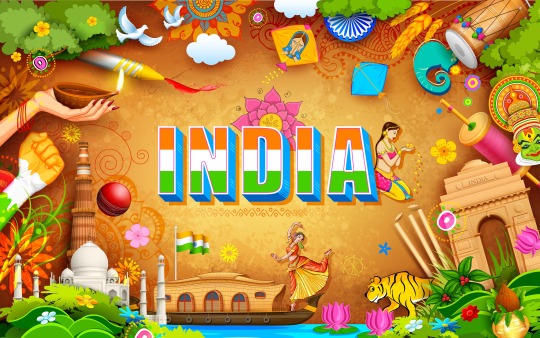
Modern Cultural Expressions:
While India's cultural heritage is deeply rooted in tradition and history, it is also a dynamic and evolving entity that continues to adapt and innovate in response to changing times. The advent of globalization, urbanization, and technology has ushered in new forms of cultural expression, from Bollywood films and indie music to contemporary art and fashion. Social media platforms like Instagram and YouTube have provided a platform for young Indian artists, musicians, and influencers to showcase their talents and connect with audiences around the world. Despite the challenges of modernization, India remains proud of its cultural heritage, embracing both tradition and innovation in equal measure.
Conclusion: India's cultural tapestry is a testament to the resilience, creativity, and diversity of its people. Across the length and breadth of the subcontinent, from the snow-capped Himalayas to the sun-drenched beaches of Kerala, the spirit of India's cultural heritage continues to thrive, enriching the lives of millions and inspiring generations to come. As we celebrate the vibrant mosaic of traditions, languages, and customs that make up the fabric of Indian society, let us also recognize the importance of preserving and safeguarding this invaluable legacy for future generations to cherish and embrace.
2 notes
·
View notes
Text
Assamese Translation Services in India - Ekitai Solutions
High quality Assamese translation Services from Native Assamese translators
Ekitai, an ISO 9001:2008 certified Assamese translation agency, offers Assamese Translation Services. We draw from a network of 150 native Assamese translators experienced in diverse industry fields offering the highest-quality Assamese translation solutions on time and budget.
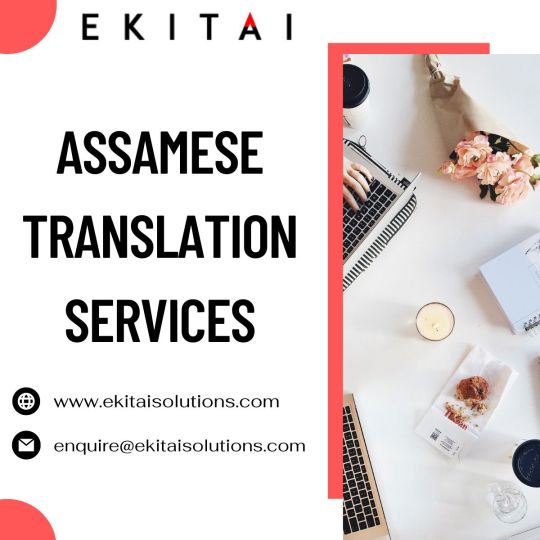
As one of the best Assamese translation companies worldwide, Ekitai offers specialized Assamese translation solutions and related business services in various industries verticals and subjects such as automotive, patents, poetry, education market research, IT (Information Technology), transport, psychology, manufacturing, investment, agriculture, architecture, travel & tourism, hospitality, legal, contracts, certificate, pharmaceutical marketing, physics, retail, religion, history, sports, electronics, energy, philosophy, medicine, law, games, biology, human resources, chemistry, geology, cooking, engineering, insurance, economics, finance pharmaceutical, government automation, zoology, computers, literature, business, astronomy, journalism, science geography, management, textiles, mathematics, marketing military, telecom (telecommunications), and media. We offer Assamese Translation Services in the following language pairs:
English to Assamese Translation Services
Assamese to English Translation Services
English to Assamese Localization Services
Assamese to English Localization Services
About Assamese Language
Assamese is an Indo-Aryan language is spoken mainly in the Indian state of Assam, Meghalaya, Arunachal Pradesh, Bangladesh & Bhutan, and some parts of Nepal. Assamese is very closely related to Bengali & Oriya, has lots of similarities, and has no grammatical gender distinction. Over 13 million native speakers speak Assamese, and the language is derived from the Sanskrit language. It uses a script similar to the Bengali script, with few additions in the number of letters.
Why Choose Ekitai Solutions for your Assamese translation services requirements?
Ekitai Solutions always uses native professional Assamese translators with years of experience in this industry. We have over 150 native professional Assamese translators working for us 24*7 across the globe. Besides, we have a rigorous selection procedure that enables us to identify professional Assamese translators in the specialized domain, ensuring quality in all our services. All our Assamese translators are well versed with modern industry standards and use CAT tools, which always helps to deliver speedy, accurate, and fluent translation. Our project managers always do two layers of internal QC before final delivery to the clients in the shortest turnaround time.
Apart from translations/localization, we offer the following services in the Assamese language:
Assamese to Assamese Audio transcription
Assamese to English Audio transcription
English to Assamese Audio transcription
Assamese to Assamese captioning
Assamese to English subtitling
English to Assamese subtitling
Assamese Video Description services
English to Assamese media localization
Assamese to English media localization
Assamese Voice Over
Assamese Dubbing
Our Assamese language Translations services include
Assamese Website Translation, Assamese Government Document Translation, Assamese Content Translation, Assamese Document translation, Assamese Website Localization, Assamese Content Localization, Assamese Audio Translation, Assamese Video Translation, Assamese Contract Translation, Assamese Technical Translation, Assamese Legal Translation, Assamese Literary Translation, Assamese Book Translation, Assamese Manual Translation, Assamese Patent Translation, Assamese Newspaper Translation, Assamese Business Translation, Assamese Financial Translation, Assamese Advertising Localization, Assamese Medical Translation, Assamese Engineering Translation, Assamese Marketing & Sales Translation, Assamese Manufacturing Translation, Assamese e-commerce translation, Assamese e-learning translation, Assamese Games translation.
2 notes
·
View notes
Text
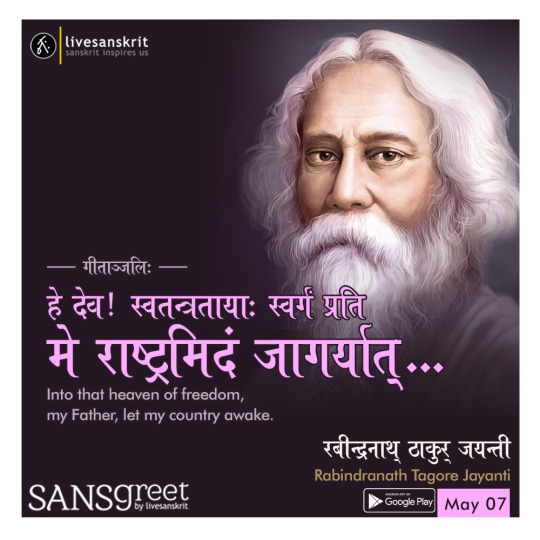
Send from Sansgreet Android App. Sanskrit greetings app from team @livesanskrit .
It's the first Android app for sending @sanskrit greetings. Download app from https://livesanskrit.com/sansgreet
Rabindranath Tagore.
Rabindranath Tagore (born Robindronath Thakur, 7 May 1861 – 7 August 1941; sobriquet Gurudev, Kobiguru, Biswakobi) was an Indian polymath - poet, writer, playwright, composer, philosopher, social reformer and painter. He reshaped Bengali literature and music, as well as Indian art with Contextual Modernism in the late 19th and early 20th centuries. Author of the "profoundly sensitive, fresh and beautiful verse" of Gitanjali, he became in 1913 the first non-European as well as the first lyricist to win the Nobel Prize in Literature. Tagore's poetic songs were viewed as spiritual and mercurial; however, his "elegant prose and magical poetry" remain largely unknown outside Bengal. He is sometimes referred to as "the Bard of Bengal".
#sansgreet #sanskritgreetings #greetingsinsanskrit #sanskritquotes #sanskritthoughts #emergingsanskrit #sanskrittrends #trendsinsanskrit #livesanskrit #sanskritlanguage #sanskritlove #sanskritupanishad #sanskritdailyquotes #sanskritdailythoughts #sanskrit #samskrit #samskritham #samskrutham #resanskrit #rabindranathtagore #tagore #gurudev #writer #composer #philosopher #socialreformer #painter #calcutta #bengal #poet # celebratingsanskrit
#greetingsinsanskrit#sanskritgreetings#sanskrittrends#trendsinsanskrit#livesanskrit#sanskrit#celebratingsanskrit#incredibleindia
1 note
·
View note
Text
Exploring the Lively World of Indian Authors
India, a land of varied countries, languages, and traditions, has a wealthy literary heritage that dates back centuries. Indian writers have created substantial contributions to earth literature, capturing the fact of the nation's ethos and showing its multifaceted society through their works. From basic epics like the Mahabharata and the Ramayana to modern books grappling with modern-day complexities, Indian literature offers a huge spectral range of styles and narratives.
Diverse Voices, Varied Stories
Among the striking features of Indian literature is their diversity. India is home to a variety of languages and countries, each using its possess literary tradition. From the musical sentiments of Tamil Sangam poetry to the intricate storytelling of Bengali literature, from the mystical Sufi poetry of Urdu to the philosophical musings of Sanskrit texts, Indian literature encompasses a kaleidoscope of sounds and perspectives.
Common Performs and Amazing Stories
Indian literature provides of amazing classics which have transcended boundaries and generations. The epics, Mahabharata and Ramayana, variety the cornerstone of Indian storytelling, embodying moral dilemmas, heroic valor, and elaborate familial relationships. The philosophical ideas of the Bhagavad Gita, embedded within the Mahabharata, continue to stimulate visitors worldwide.
In the sphere of modern literature, Indian writers have garnered global praise for his or her poignant stories and evocative storytelling. Salman Rushdie's "Midnight's Children" and Arundhati Roy's "The God of Small Things" are celebrated types of contemporary Indian literature, exploring themes of personality, politics, and social upheaval.
Emerging Sounds and New Perspectives
The landscape of Indian literature is continually changing, with emerging authors getting new views and narratives to the forefront. Authors like Aravind Adiga, whose introduction story "The White Tiger" gained the Person Booker Prize, and Jhumpa Lahiri, acclaimed on her behalf insightful portrayals of the immigrant experience, have received common acceptance for his or her compelling storytelling.
Furthermore, Indian literature is seeing a resurrection in local sounds, with authors like Perumal Murugan, Chandrakanta, and Vivek Shanbhag gaining prominence for his or her performs in regional languages like Tamil, Kannada, and Marathi, respectively. These experts enrich the literary tapestry of India by giving ideas to the national subtleties and societal character of their particular regions.
Difficulties and Options
Despite their wealthy heritage and strong skill pool, Indian literature faces a few issues, including linguistic barriers, restricted use of publishing programs, and the dominance of English-language publishing. Several regional languages struggle for recognition and dissemination, blocking the visibility of indigenous literary traditions.
But, the digital age has opened up new paths for Indian authors, permitting self-publishing, online tools, and international distribution channels. Social media marketing and digital neighborhoods offer authors with opportunities to connect with viewers global, fostering a far more inclusive and varied fictional landscape.
Celebrating Indian Literature
Once we enjoy the vibrant tapestry of Indian literature, it is vital to acknowledge the position of Indian experts in surrounding the social and intellectual discourse of the nation. Their reports resonate with readers across borders, transcending linguistic and ethnic limits to supply glimpses into the human experience in all its complexity.
Whether delving in to historical mythologies or grappling with contemporary issues, Indian authors continue steadily to stimulate, provoke, and concern readers using their strong narratives and profound insights. Even as we navigate the ever-changing currents of the fictional world, Indian literature stays a beacon of imagination, variety, and resilience, reaffirming their rightful place on the international pointIndia, a area of diverse countries, languages, and traditions, has an abundant literary heritage that appointments back centuries. Indian experts have produced substantial contributions to world literature, recording the fact of the nation's ethos and sending its multifaceted culture through their works. From traditional epics such as the Mahabharata and the Ramayana to modern novels grappling with modern-day difficulties, Indian literature supplies a substantial spectral range of styles and narratives. Indian Authors
Varied Sounds, Diverse Experiences
One of many impressive top features of Indian literature is its diversity. India is house to a multitude of languages and countries, each having its own fictional tradition. From the musical sentiments of Tamil Sangam poetry to the delicate storytelling of Bengali literature, from the mystical Sufi poetry of Urdu to the philosophical musings of Sanskrit texts, Indian literature encompasses a kaleidoscope of sounds and perspectives.
Common Works and Timeless Reports
Indian literature delivers of classic classics that have transcended edges and generations. The epics, Mahabharata and Ramayana, kind the cornerstone of Indian storytelling, embodying moral dilemmas, heroic valor, and elaborate familial relationships. The philosophical insights of the Bhagavad Gita, embedded within the Mahabharata, continue to stimulate visitors worldwide.
In the kingdom of modern literature, Indian writers have garnered international acclaim for his or her moving narratives and evocative storytelling. Salman Rushdie's "Midnight's Children" and Arundhati Roy's "The Lord of Little Things" are celebrated samples of modern Indian literature, discovering styles of identity, politics, and social upheaval.
Emerging Sounds and New Views
The landscape of Indian literature is continually developing, with emerging authors providing new views and narratives to the forefront. Writers like Aravind Adiga, whose debut book "The White Tiger" won the Man Booker Treasure, and Jhumpa Lahiri, acclaimed for her topical portrayals of the immigrant knowledge, have gained popular acceptance because of their convincing storytelling.
Furthermore, Indian literature is observing a revival in regional comments, with authors like Perumal Murugan, Chandrakanta, and Vivek Shanbhag increasing prominence due to their works in local languages like Tamil, Kannada, and Marathi, respectively. These authors enrich the fictional tapestry of India by offering ideas into the ethnic nuances and societal dynamics of their particular regions.
Difficulties and Options
Despite its wealthy heritage and strong talent share, Indian literature encounters many problems, including linguistic barriers, limited use of publishing tools, and the dominance of English-language publishing. Several regional languages struggle for acceptance and dissemination, blocking the presence of indigenous fictional traditions.
However, the digital era has opened up new ways for Indian experts, permitting self-publishing, on line systems, and worldwide distribution channels. Social networking and digital towns give experts with opportunities to connect with viewers worldwide, fostering an even more inclusive and diverse literary landscape.
Celebrating Indian Literature
Once we observe the lively tapestry of Indian literature, it is essential to recognize the role of Indian writers in surrounding the cultural and intellectual discourse of the nation. Their reports resonate with viewers across edges, transcending linguistic and social limits to supply glimpses to the human experience in every its complexity.
Whether delving into ancient mythologies or grappling with contemporary issues, Indian writers continue to stimulate, provoke, and challenge viewers using their powerful narratives and profound insights. Even as we steer the ever-changing currents of the literary world, Indian literature stays a beacon of imagination, diversity, and resilience, reaffirming their rightful put on the global stage
0 notes
Text
Bengali Books Website, Ananda Publishers Online
In Hirangarh, no one had ever seen the guy before. The man who appeared to be amnesiac was the root cause of all the chaos. Ramesh Guna offered him refuge. ‘Gopal’ was his given name. Dinesh Guna, the deceased father of Ramesh, resurfaces as a ghost and meets Gopal. It's challenging to comprehend Gopal's identity. Some claim that he is the mobster Lalu Mondal. Whereas, police consider him to be SDPO Madhav Sarkar. In the meantime, Neelu met Baghu in the Hirangarh forest. The latter has excellent tree-climbing skills and can watch out for the miscreants. Again, a sadhu Baba appears in Ramacharan’s dream and gifts him one percent Brahmagyan. The latter again speaks to Ramacharan.
Interesting? Visit bengali books website and look for Shirshendu Mukherjee’s juvenile fiction, Hirangarher Byaparshyapar.
During the lockdown, Mitadru and Sneha lived in seclusion in two separate New Town residential complexes. They communicated each other only through calls on cellphones. Unbeknownst to them, a mutual reliance emerged, and subconscious feelings of love were sown that culminated two years later at Mitadru's fiancé Haimanti's Santiniketan home. Krishnendu Mukherjee’s Sedin Chaitramas is a book about pure love with Tagorean theme. The bard has been referred to in different contexts in the narrative by Biswarup Mitra’s (Haimanti’s father, who idol worships Tagore) Rabindra-esque references and through the occasional poetry and songs of Sneha and Mitadru.
Another book with elements of Tagore in the backdrop is Kusumbij. A few months after Rabindranath's demise on Baishe Shravan, the surveyor Shuddsheel, who was a devoutTagore fan, visited Birda village to survey territory for the British Army during World War II. He fell in love with Tamalika who was mourning the loss of Rabindranath.
Eighty-two years later, while working on an eco-village project in Birda, Ishita, a civil engineer, began looking for references on Tamalika’s life. Simultaneously, a unique relationship blossom between Ishita and Sangram Bhattacharya. The latter is determined to prevent the Eco Village Project company from acquiring his land for the project.
This International Kolkata bookfair Ananda Publishers has brought out an anthology with Krishnendu Mukherjee’s two stories— Sedin Chaitramas and Kusumbij. Please visit our stall in the fair ground. In case you cannot make it, do access Ananda publishers online, www.anandapub.in for your favourite title.
order bengali books online, ananda publishers
Anjan Sengupta’s …Ebang Apala Atreyi documents the interests and goals of ancient Indian women-sages who were advocates of Vedic literature. They were significantly knowledgeable beyond their time and as modern men-sages of the Vedic era, these women-sages were conversant with the Vedas and Upanishads and could easily engage in argument with the male philosophers of their times. The focal point of this narrative is these female sages, proficient in philosophy who carried shaven head with chotis behind their head and wore attire like their male counterparts. They were honoured not only by common men but by kings as well.
The Ananda online bookfair has begun and it’s raining discounts up to 25 percent for the avid readers of Bengali books by using specific coupon codes. The Tintin samagra is also available at a lucrative offer price using coupon code TINTINNEW. One can order bengali books online from any corner of the world and avail the offers.
0 notes
Text
"Bridal Brilliance: Rediscovering the Splendor of Bengali Wedding Traditions Through the Artistry of Deenas Makeover"
Introduction:
Bengali weddings, steeped in tradition and cultural opulence, unfold as a captivating tapestry of rituals and timeless elegance. Amidst the grandeur, the spotlight shines brightest on the bridal look, an art form perfected by the unparalleled expertise of the best bridal makeup artist in Kolkata, Deena from Deenas Makeover.
Bengali Wedding Traditions: A Cultural Odyssey
A symphony of sacred rituals, from the blessings of "Aashirwad" to the lively revelry of "Boubhat," defines Bengali weddings. Each ceremony is a profound celebration of love, family, and cultural identity. The bridal look, an ode to these traditions, emerges as a vital expression that adds grace to every ritual, weaving stories of heritage with each stroke.
Saree Draping: A Canvas of Elegance
The iconic red and white Bengali saree, adorned with intricate Banarasi weaves, becomes the canvas of tradition. The best bridal makeup artist in Kolkata, Deena, possesses an innate understanding of how to enhance this timeless ensemble. Her makeup palette effortlessly complements the saree's elegance, creating a visual symphony that harmonizes colors and textures.
Bridal Makeup: A Tale of Individual Beauty
Enter the realm of Deenas Makeover, recognized as the best bridal makeup artist in Kolkata. Deena's artistry transcends conventional norms, transforming bridal dreams into reality. Each brushstroke is a meticulous expression, enhancing the bride's natural beauty while preserving the cultural essence of a Bengali wedding. The result is a celebration of individuality, where beauty meets tradition in a seamless dance.
Expressive Eyes: The Poetry of Bridal Gaze
Bengali bridal makeup is a poetic play on expressive eyes, where kajal-rimmed depths convey volumes of emotion. Deena, the best bridal makeup artist in Kolkata, adeptly balances intricate eye shadow, creating a mesmerizing gaze that narrates tales of joy, anticipation, and love. The eyes become a canvas for the bride's innermost emotions.
Radiant Glow: Ornaments of Tradition
Traditional jewelry, including the "Mukut," "Chik," and "Nath," elevates the bridal look to celestial heights. Deenas Makeover delicately weaves the cultural significance of these ornaments with modern elegance, ensuring the bride exudes a radiant glow. Each piece tells a story, adding layers of meaning to the overall bridal ensemble.
Conclusion: A Masterpiece Unveiled
In the kaleidoscope of Bengali wedding culture, the bridal look emerges as a masterpiece, and the brush wielded by the best bridal makeup artist in Kolkata, Deena, is its key. Deenas Makeover, with its fusion of tradition and contemporary flair, crafts bridal looks that transcend time. Trust in Deena's expertise to curate a bridal experience harmonizing cultural heritage with individual beauty, making every Bengali bride a vision of grace on her special day. As tradition meets expertise, the result is a breathtaking blend of elegance, style, and timeless allure, where Deenas Makeover paints each bride as a unique work of art.
#BridalBrilliance#BengaliWeddingMagic#DeenasMakeover#KolkataBridalArtistry#TraditionRedefined#CulturalElegance#ExpressiveBridalEyes#TimelessBeauty#BestMakeupArtistKolkata#BengaliSareeStyle#ArtOfAdornment#BridalGlow#IndividualityCelebrated#PoetryInMakeup#RadiantBride#BridalJewelryTales#BreathtakingElegance#DeenasMasterpiece#BengaliBridalTradition#EtherealBride#BridalStoriesUnveiled#CulturalHarmony#BengaliBeauty#BridalDreamsRealized#KolkataWeddingScene#UniqueBridalArtistry
0 notes
Text
Cultural Tapestry: Celebrating Navi Mumbai's Festivals and Traditions
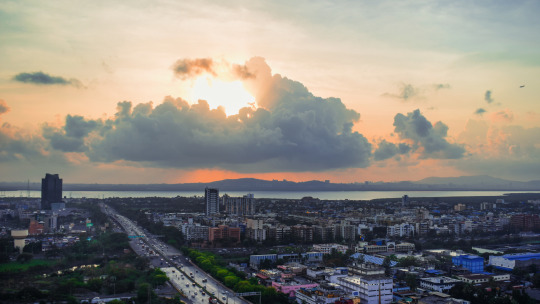
Navi Mumbai is often characterized as a modern planned city with gleaming infrastructure catering to 21st century aspirations. But beneath the contemporary exterior lies a vibrant cultural fabric woven from Maharashtrian traditions, festivals and a potpourri of ethnic influences.
Traditional Festivals
The residents of Navi Mumbai celebrate all major Indian festivals infusing their unique local flavor to these joyous occasions.Ganesh ChaturthiThe 10-day Ganesh Chaturthi festival devoted to the elephant-headed god Ganesha sees Navi Mumbai decked out in lights and color. From street corners to housing societies, the city revels in welcoming Ganesha idols of all sizes to the chanting of Vedic hymns.Ganesh Chaturthi CelebrationsNavi Mumbai celebrates Ganesh Chaturthi with great fervorThe idols are immersed in the sea on the last day in an elaborate ceremony that is both spectacular and symbolic.NavratriThe nine nights of Navratri dedicated to the triumph of good over evil is marked in Navi Mumbai with late night garba dance sessions. People turn up in traditional outfits to whirl and clap to live music in large temporary arenas called garba grounds.Mount Mary FairThe annual Mount Mary Fair held in the township of Kalamboli near Panvel is a shining example of Navi Mumbai's multiculturalism.Mount Mary Fair, KalamboliThe Mount Mary Fair showcases Navi Mumbai's multicultural fabricPeople from all faiths gather at the Mount Mary Basilica for the week-long fair that has stalls selling toys, clothes and food from across India.1 The festivities and bonhomie during the fair bring out the unifying strands of Navi Mumbai's composite culture.
Art & Culture
Navi Mumbaikars also celebrate local arts, theater and literature through various groups and organizations.CIDCO UtsavCIDCO Utsav is an annual cultural festival organized by CIDCO that provides a platform to local artists and performers. The festival showcases an eclectic range from Warli tribal dances to Marathi theater, rock music competitions and a handloom exhibition over 3 days.Kala Ghoda Arts FestivalNavi Mumbai has its own edition of Mumbai’s iconic Kala Ghoda Arts Festival held every year. The festival brings together artists, musicians, dancers and writers from Navi Mumbai and across India celebrating creativity.Navi Mumbai Bengali AssociationWith migrants from West Bengal being an integral part of Navi Mumbai’s growth, the Navi Mumbai Bengali Association aims to nurture and promote Bengali culture. The group celebrates Bengali festivals, poetry sessions and is also involved in community service initiatives.3Such organizations and events ensure that arts and culture continue to pulsate within the planned infrastructure of Navi Mumbai.
Religious Places
Along with festivals, shrines and places of worship also showcase Navi Mumbai’s multicultural fabric co-existing in harmony. From historic Hindu temples to churches, mosques, gurudwaras and even a Zoroastrian fire temple, the city houses diverse religious structures.Mumbadevi TempleThe Mumbadevi Temple lends its name to Mumbai and is dedicated to the city’s patron goddess Mumba. The historic temple was moved from Mumbai to its current location in Nerul during the development of Navi Mumbai.St. John Bosco ChurchThe striking St. John Bosco Church with architecture inspired by early Christian Catacombs is a well-known Catholic place of worship in Navi Mumbai located in Seawoods.Chhatrapati Shivaji Maharaj TempleThe Chhatrapati Shivaji Maharaj Temple is an expansive temple complex in Kharghar housing shrines dedicated to Hindu deities, saints and the Maratha ruler Shivaji along with exhibition halls, fountains and gardens.Such religious spaces bind together communities in Navi Mumbai through a shared spirituality that transcends individual beliefs.
Cultural Outlook
As more migrants move to Navi Mumbai for education and employment opportunities, the city is organically evolving into a melting pot of cultures. The urban planners are also aiming to build dedicated cultural zones in Kharghar and Ulwe where artists and performers can thrive.5With support from civic authorities and enterprising residents, Navi Mumbai has the potential to emerge as a leading cultural hub that blends traditions with contemporary expressions. The city’s inclusive ethos forged from its migrant roots allows diverse art forms, cuisine and lifestyles to flourish in harmony.From ancient temple rituals to avant-garde theatre, Navi Mumbai’s cultural tapestry stitches together history, creativity and community bonding into a vibrant habitat.
0 notes
Text
Kalpana Poetry by Rabindranath Tagore PDF
Kalpana Poetry by Rabindranath Tagore Bengali PDF.
Name of Book – Kalpana,
Author – Rabindranath Tagore
Book Format – PDF,
Genre – Bengali Poetry Book,
Book Pages – 138,
PDF Size – 2 MB,
Rabindranath Tagore wrote the Bengali Poetry Book Kalpana.
Rabindranath Tagore, a polymath from India, made significant contributions to modern poetry, and his influence extends far beyond the boundaries of his…
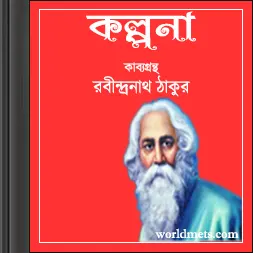
View On WordPress
0 notes
Text
Best novelist in hindi
The title of "best novelist in Hindi" can be subjective and may vary depending on individual preferences. However, some widely acclaimed Hindi novelists include Munshi Premchand, Harivansh Rai Bachchan, and Amrita Pritam, among others. Each of them has made significant contributions to Hindi literature in their own unique way.

Determining the "best" writer in Hindi is subjective and can depend on personal preferences, genres, and themes that resonate with individual readers. However, several writers in Hindi literature have made significant contributions and are highly regarded. Here are some of the most prominent and influential Hindi writers:
1. **Munshi Premchand:** Often referred to as the "Upanyas Samrat" or "Emperor of Novels," Munshi Premchand is considered one of the greatest Hindi writers of all time. His stories and novels, which often focused on social issues, continue to be widely read and appreciated.

2. **Harivansh Rai Bachchan:** A renowned poet and writer, Harivansh Rai Bachchan's works, including "Madhushala" and "Agneepath," have left an indelible mark on Hindi literature. His poetry is celebrated for its depth and philosophical themes.

3. **Jaishankar Prasad:** Jaishankar Prasad was a leading figure in the Chhayavad movement, known for his lyrical and romantic poetry. His epic "Kamayani" is considered a masterpiece.

4. **Sumitranandan Pant:** A prominent poet of the Chhayavad era, Sumitranandan Pant's poetry is known for its spiritual and philosophical themes. "Gunaahon Ka Devta" is one of his well-known works.

5. **Suryakant Tripathi Nirala:** Nirala was a versatile writer known for his poetry, essays, and novels. His poems often dealt with social issues and human suffering.

6. **Dharamvir Bharati:** Known for his novel "Gunahon Ka Devta," Dharamvir Bharati's literary contributions are highly regarded, particularly in the realm of modern Hindi fiction.
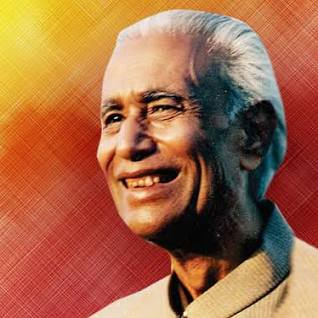
7. **Rahul Sankrityayan:** A prolific writer and traveler, Sankrityayan's works spanned various genres, including travelogues, essays, and novels. He is known for his significant role in popularizing Buddhism in India.

8. **Kamleshwar:** An influential writer and scriptwriter, Kamleshwar's works often explored contemporary urban life and societal changes. "Kitne Pakistan" is one of his notable novels.
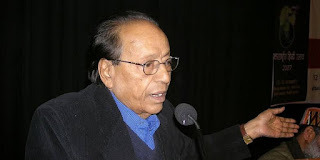
9. **Phanishwar Nath Renu:** Known for his novel "Maila Anchal," Renu's storytelling depicted the rural life and culture of Bihar with great authenticity.

10. **Ashapurna Devi:** A prominent Bengali writer who also wrote in Hindi, Ashapurna Devi's novels, especially the "Subarnalata" series, are celebrated for their exploration of women's issues and societal changes.
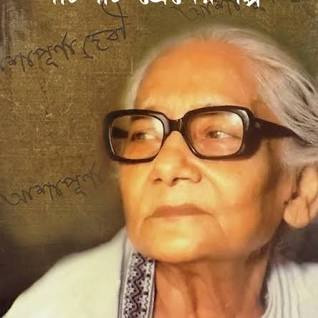
These are just a few of the notable writers in Hindi literature, and there are many more talented authors who have made significant contributions to the language and culture. The "best" writer in Hindi ultimately depends on your personal preferences and the themes or styles that resonate with you.
1 note
·
View note
Text
Exploring the Rich Tapestry of Indian Literature: Tila Lake Literature Collection
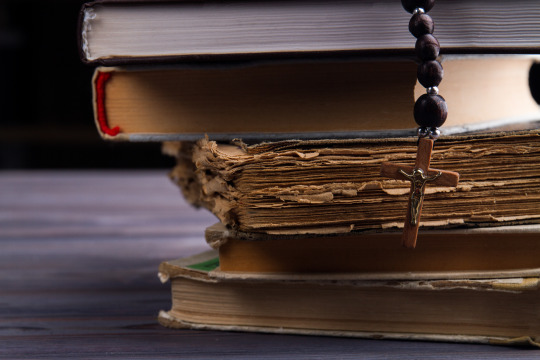
Introduction
India, known for its diverse culture and heritage, boasts a literary tradition that dates back centuries. The Tila Lake Literature Collection holds a special place in this vast literary landscape. This unique collection of scholarly works represents a fusion of cultural, historical, and artistic elements, making it a treasure trove of knowledge. This article will delve into the Tila Lake Literature Collection, exploring its historical significance, literary diversity, and contribution to Indian culture.
The Origin and Significance of Tila Lake
Tila Lake, nestled in the scenic landscapes of India, has been a source of inspiration for generations of poets, writers, and scholars. Its pristine waters and serene surroundings have been a muse for numerous literary works. The lake's name, "Tila," derives from the Sanskrit word "tila," which means sesame. This ancient lake has a rich history and is often associated with spirituality and storytelling.
The Tila Lake Literature Collection primarily comprises works that draw inspiration from the lake, its surroundings, and India's diverse cultures. Its significance lies in preserving the region's cultural heritage and capturing the essence of the Indian way of life.
Historical Context
To truly appreciate the Tila Lake Literature Collection, one must understand its historical context. This collection has its roots in the rich tradition of oral storytelling that dates back to ancient India. These stories often passed down through generations, were eventually transcribed, giving rise to a literary tradition deeply intertwined with Indian history and culture.
One of the notable aspects of the Tila Lake Literature Collection is the diversity of languages and dialects. India is a linguistic melting pot, with hundreds of languages spoken nationwide. The collection includes works in Sanskrit, Tamil, Marathi, Bengali, and many others. This linguistic diversity reflects the multi-faceted nature of Indian society.
Literary Diversity
The Tila Lake Literature Collection is a testament to the diverse genres and themes explored by Indian writers. It encompasses poetry, prose, epics, folklore, and philosophical treatises. Each work in the collection is a unique window into different facets of Indian life and thought.
Epic Poetry: The collection features epic poems that narrate stories of courage, love, and mythology. Works like the Ramayana and the Mahabharata, integral to Indian literature, are central to the collection.
Folklore and Myths: Folktales and myths from different regions of India are also found in the collection. These stories provide insights into the cultural beliefs and practices of various communities.
Spiritual and Philosophical Texts: India is renowned for its spiritual and philosophical traditions. The Tila Lake Literature Collection includes texts like the Upanishads and the Bhagavad Gita, which explore profound philosophical concepts.
Modern Literature: While the collection has deep historical roots, it also includes contemporary works from renowned Indian authors. These works offer a glimpse of the country's evolving literary landscape.
Preserving Cultural Heritage
The Tila Lake Literature Collection is crucial in preserving India's cultural heritage. The texts found here are a source of knowledge and a means of connecting with the past. They provide insights into the bygone eras' customs, traditions, and way of life.
The collection bridges generations, allowing younger Indians to connect with their roots and gain a deeper understanding of their cultural identity. It is a valuable resource for scholars, researchers, and anyone interested in exploring India's rich literary heritage.
Personal Experience and Insights
Having had the privilege of visiting Tila Lake and studying some of the texts in the collection, I can attest to its profound impact on one's understanding of Indian culture. The serenity of the lake and the stories it has inspired leave a lasting impression. It's a place where art and nature intersect, creating a harmonious blend of inspiration and beauty.
Conclusion
The Tila Lake Literature Collection in India is a testament to the country's literary richness. It represents a unique fusion of history, culture, and artistry. Its preservation of ancient texts and its contribution to the diversity of Indian literature make it an invaluable resource. Whether you are a literature enthusiast, a historian, or simply someone curious about India's cultural tapestry, the Tila Lake Literature Collection offers a fascinating journey into the heart of India's literary heritage.
In exploring this collection, one can truly appreciate the principles of expertise, Authoritativeness, Trustworthiness, and Experience. It is a reservoir of knowledge and cultural insights, where India's past continues to weave its influence into the present, fostering a deep appreciation for the nation's literary treasures.
0 notes
Text
The Melodic Reverberations of Emotions and Culture in Hindi Kavita.
One of the world’s most spoken languages, Hindi, is also home to a treasure trove of literature, the most compelling of which is Hindi poetry. The rhythmic poems of Hindi kavita are more than simply words on paper; they are a conduit through which souls are connected and through which profound emotions may be expressed. In this post, we’ll dig into the fascinating world of Hindi Kavita and learn about its history, many forms, famous poets, and lasting social effect.
History and Development

Famous Poets and What They’ve Done for Poetry
Many famous authors with lasting literary legacies may be found in Hindi Kavita. Mirza Ghalib, known as the “Last of the Classical Urdu Poets,” is admired the world over for his heartfelt poetry that is not limited by linguistic limitations. Rabindranath Tagore is more commonly known with Bengali literature, although he also made significant contributions to Hindi Kavita. Harivansh Rai Bachchan’s writings, praised for their poignancy and social insight, have remained popular for decades. Kavita Hindi Mein is indeed the best. A rich tapestry of Hindi poetry quality has been fashioned by the likes of Jaishankar Prasad and Ramdhari Singh Dinkar, as well as the more modern fervour of Gulzar and others.
Social Consequences
Hindi Kavita is more than just a collection of poems; it has become a potent social and cultural force. Hindi poets used their lyrics as potent means of resistance throughout India’s fight for independence, rallying the masses with demands for freedom and solidarity. Kavitayen in Hindi has the finest results. Poets like Nagarjun and Mahadevi Varma spearheaded a reformist movement that used the lyrical beauty of poetry to address social concerns and advocate for human rights.
Maintaining History in the Present

Conclusion
Hindi kavita is not merely a literary genre, but a storehouse of human experience and wisdom. Its poems capture universal experiences, stories, and ideologies in a way that is both timeless and universal. Motivational Hindi Kavita will change your mind. Hindi Kavita, from its lyrical ghazals to its deep dohas, is a monument to the strength of language and the breadth of human experience. Inspiring minds to contemplate, feel, and enjoy life’s beauty across decades and cultural divides, Hindi Kavita will continue to reverberate as long as hearts beat and emotions flow.
0 notes
Text
How to Prepare UPSC Maithili Language Paper 2022 – IAS Mains
best ias coaching in bangalore is Maithili is one of the three main languages of Bihar State including Magdahi and Bhojpuri. It is the language of old Mithila ( the area of the ancient Videha, currently Tirhut). It is an Indo-Aryan language of the Indo-European language family. It is also the only Bihari language with a script of its own, named Tirhuta.
The success rate of candidates opting for literature subjects is consistently rising. Everyone is aware of the importance of the optional subject in the UPSC mains exam. Before opting for an optional subject, candidates must keep a few things in mind. What is the current demand and scope of the subjects, and how much effort do they need to put in to get a good score in the optional subject.
Tips to Prepare for the UPSC Maithili language papers 2022
Go through the syllabus of the optional subject thoroughly.
Prepare a study plan.
Identify the standard books and notes required to prepare for this subject.
Work on timeline and deadlines.
Prepare your notes for preparation.
Practice previous year’s question papers.
Give mock exams.
Syllabus
MAITHILI
PAPER I
HISTORY OF MAITHILI LANGUAGE AND ITS LITERATURE
(Answers must be written in Maithili) PART A
History of Maithili Language
Place of Maithili in Indo-European Language family.
Origin and development of Maithili language. (Sanskrit, Prakrit, Avhatt, Maithili)
Periodic division of Maithili Language. (Beginning, Middle era, Modern era).
Maithili and its different dialects.
Relationship between Maithili and other Eastern languages (Bengali, Asamese, Oriya)
Origin and Development of Tirhuta Script.
Pronouns and Verbs in Maithili Language.
PART B
History of Maithili Literature
Background of Maithili Literature (Religious, Economic, Social, Cultural).
Periodic division of Maithili literature.
Pre-Vidyapati Literature.
Vidyapati and his tradition.
Medieval Maithili Drama (Kirtaniya Natak, Ankia Nat, Maithili dramas written in Nepal).
Maithili Folk Literature (Folk Tales, Folk Drama, Folk Stories, Folk Songs).
Development of different literary forms in modern era :
Prabandh-kavya
Muktak-kavya
Novel
Short Story
Drama
Essay
Criticism
Memoirs
Translation
Development of Maithili Magazines and Journals.
PAPER -II
(Answers must be written in Maithili)
The paper will require first-hand reading of the prescribed texts and will test the critical ability of the candidates.
PART A
Poetry
Vidyapati Geet-Shati—Publisher : Sahitya Akademi, New Delhi (Lyrics— 1 to 50)
Govind Das Bhajanavali—Publisher : Maithili Acadamy, Patna (Lyrics— 1 to 25)
Krishnajanm—Manbodh
Mithilabhasha Ramayana—Chanda Jha (only Sunder-Kand)
Rameshwar Charit Mithila Ramayan—Lal Das (only Bal-kand)
Keechak-Vadh—Tantra Nath Jha.
Datta-Vati—Surendra Jah ‘Suman’ (only 1st and 2nd Cantos).
Chitra-Yatri
Samakaleen Maithili Kavita—Publisher: Sahitaya Akademi, New Delhi.
PART-B
Varna Ratnakar—Jyotirishwar (only 2nd Kallol)
Khattar Kakak Tarang—Hari Mohan Jha
Lorik—Vijaya Manipadma
Prithvi Putra—Lalit
Bhaphait Chahak Jinagi—Sudhanshu ‘Shekhar’ Choudhary
Kriti Rajkamlak—Publisher: Maithili Acadamy, Patna (First Ten Stories only)
Katha–Sangrah–Publisher: Maithili Acadamy, Patna
Reference books
Recommended books for Maithili:
Maithili Sahityak Itihas – Dr. Durganath Jha “Shreesh”, Jaykant Mishra, Dr. Dinesh Kumar Jha
Maithili Patrakaritak Itihas – Chandranath Mishra Amar
Tirhuta Lipik Vikas – Dr. Rajeshwar Jha
Maithili Kathak Vikas – Sahitya Academy, New Delhi
Maithili Padyak Vikas – Sahitya Academy, New Delhi
Maithili Gadyak Vikas – Sahitya Academy, New Delhi
Maithili Parichayika
Prepare a study plan
Make a monthly, weekly, and daily plan based on the number of hours you have in a day to devote to preparation.
Stick to this plan modifying it when needed.
Usually, it takes around 3-4 months to complete the optional subject so use this time wisely.
Practice previous year’s Mains exam question papers
Use the previous year’s papers as your guide to predicting the questions that can be asked in future.
UPSC has a tendency to repeat questions by changing certain keywords.
Candidates who have a strong grip on the past papers have higher chances of scoring good marks in the actual examination.
Important topics from Paper 1 and 2
Paper 1 contains History of Maithili Language and History of Maithili Literature. The topics from for Paper 2 in Optional Languages will require first-hand reading and will be designed to test the critical ability of the candidate.
We all know that in the final list, optional paper marks are crucial to deciding rank.
Students have to perform well on the preferred paper. Since the rest of the papers are compulsory for all, it’s only the optional paper that can make or break your fortune. So don’t go for the selective reading, as there is a single optional paper.
Who can opt for the Maithili language paper for the IAS Exam?
This language is spoken by the people of the Indian state of Bihar in the northern and eastern regions. As an optional subject, candidates can opt for the Maithili language if they have graduated in the literature of Maithili language as the main subject. It is highly recommended for people who are good in the language. The syllabus is more or less static and limited.
If the candidate is creative and has a good conceptual understanding of the subject this optional is good for them. Good writing skill is also required.
Preparation tips for candidates
Clear the basic concepts of the Maithili language to handle paper 2
Every language demands good writing skills, so don’t forget to work on it.
Attempt the essay question at least with at least 40 minutes to spare. Write it in a simple and effective language. Write the essay after winding up the other sections. so, candidates write and elaborate the essay accordingly, without wasting time.
Developing a reading habit of newspapers of the Maithili language, at least 15-20 minutes every day improves writing skills and gives students the awareness of the recent and modern writing patterns of their language and vocabulary.
#IASCoachingBangalore#BestIASInstitutes#CivilServicesPreparation#TopCoachingCenters#ExpertGuidance#SuccessInIAS#StudyMaterials#IASExamPreparation#BangaloreCoaching#CivilServicesCoaching
1 note
·
View note